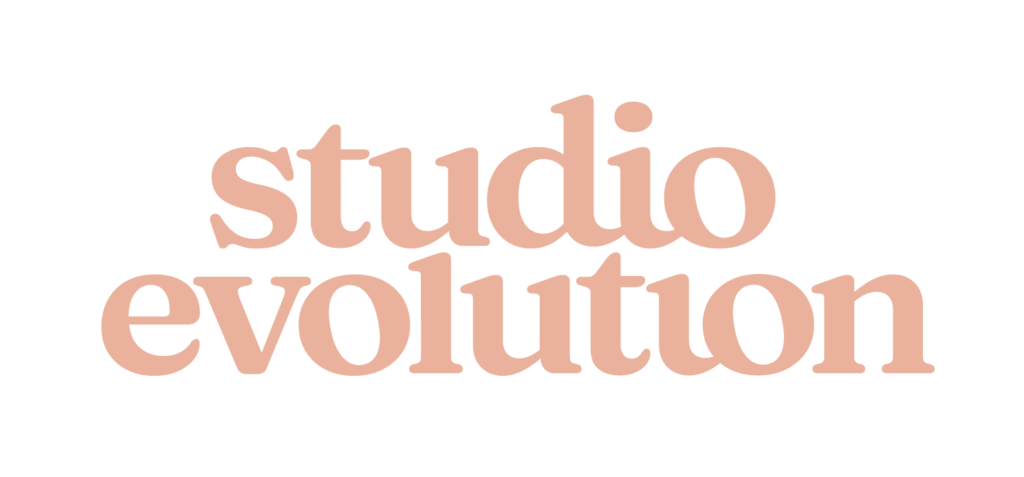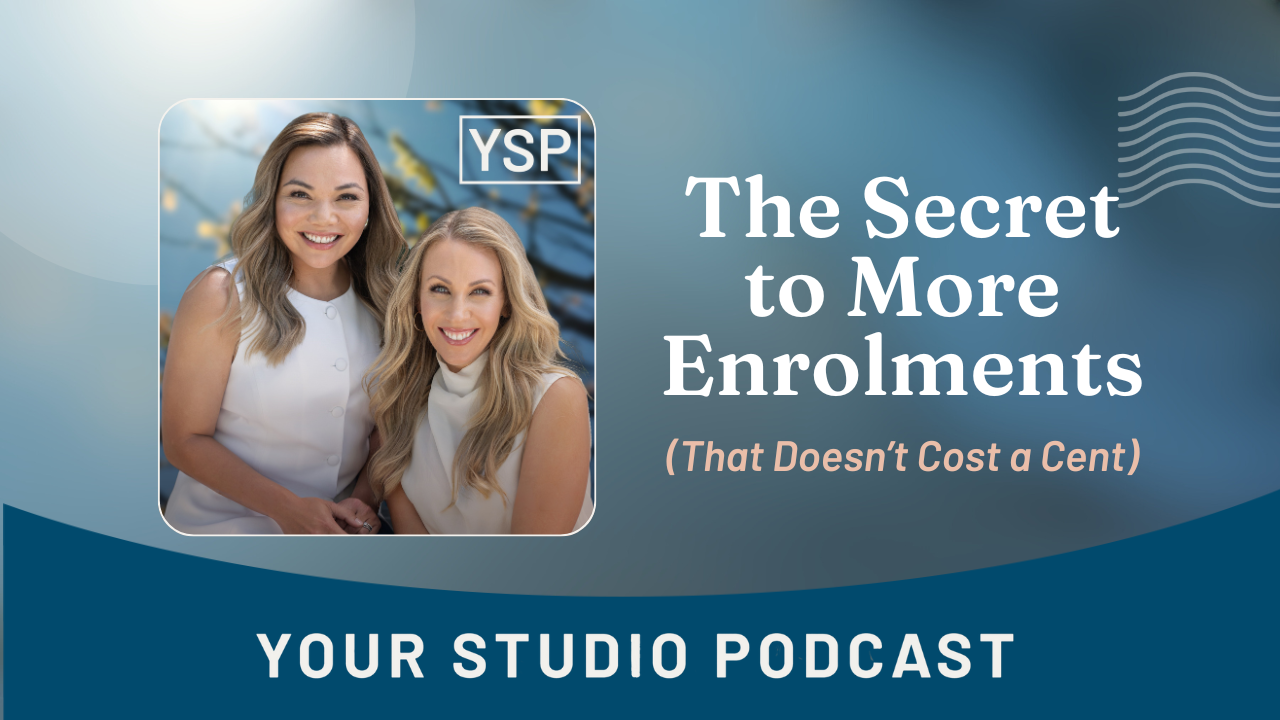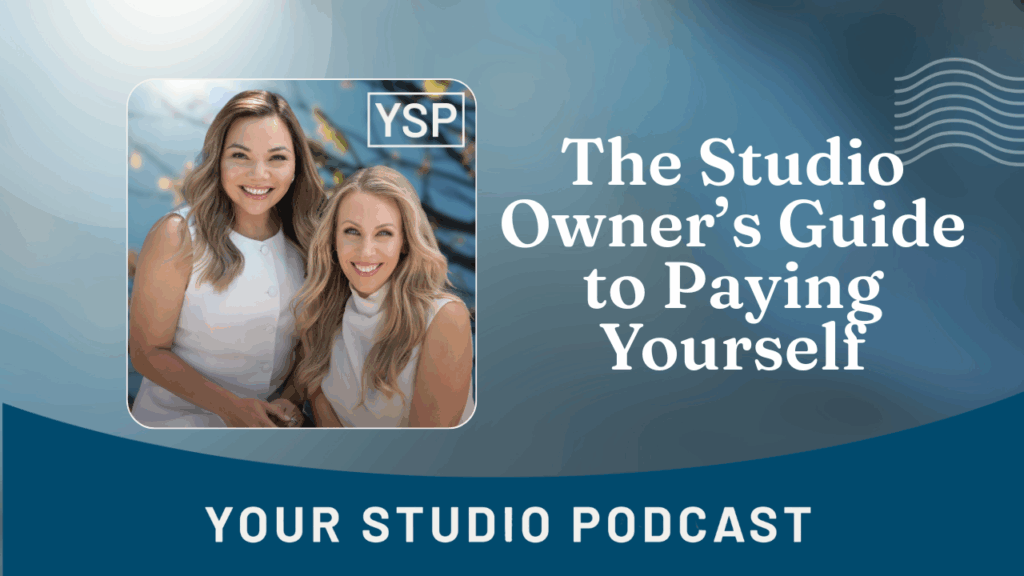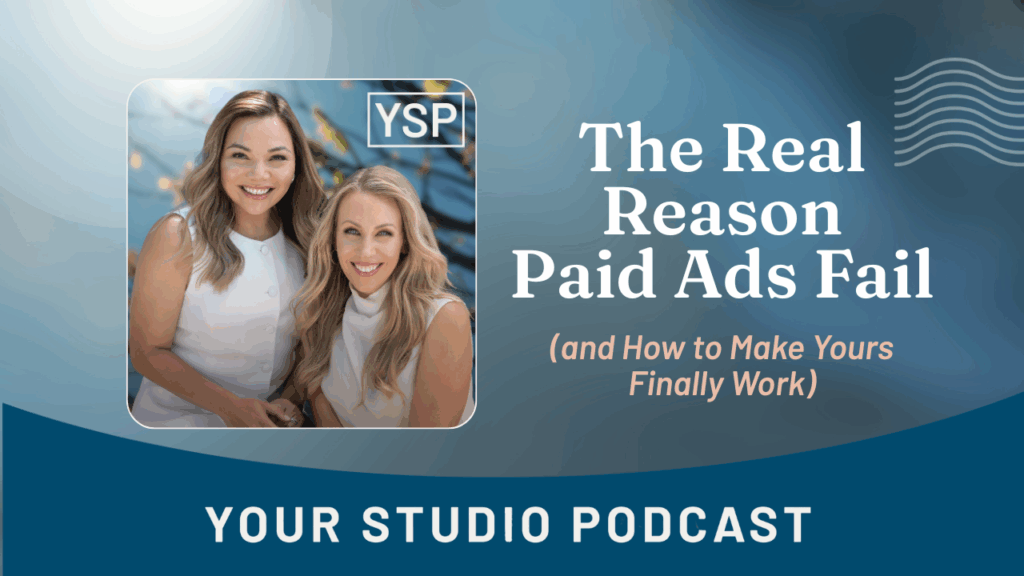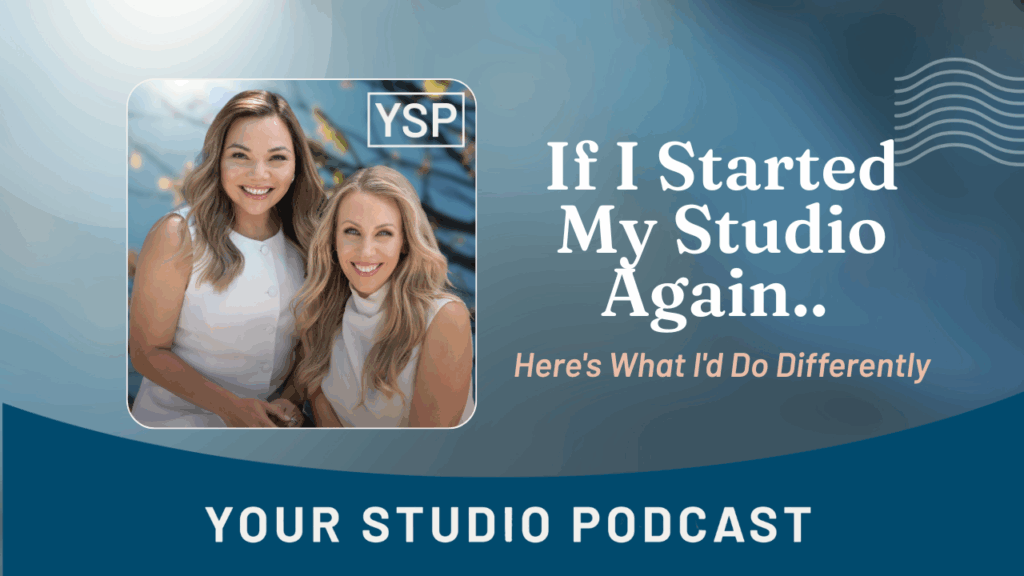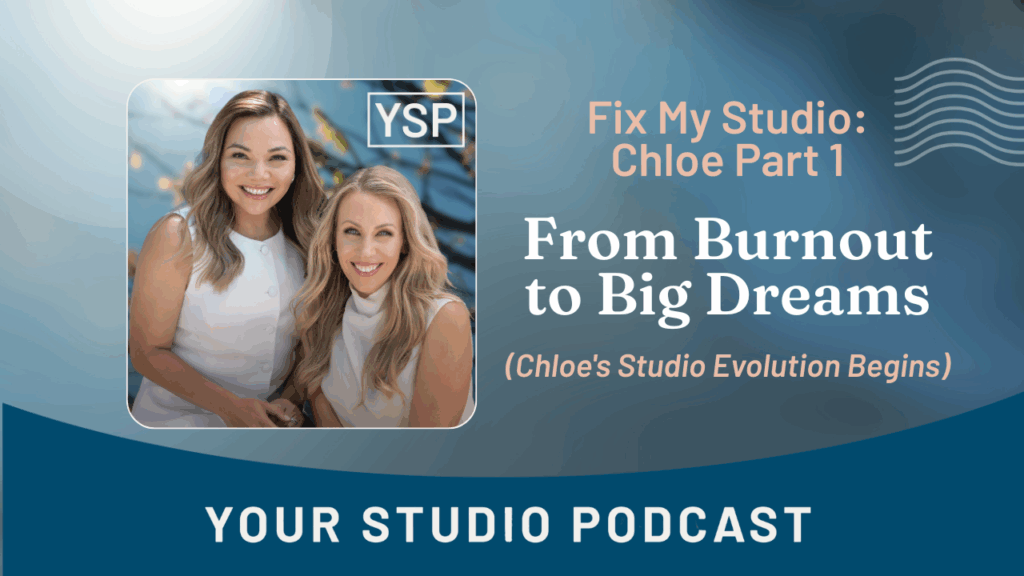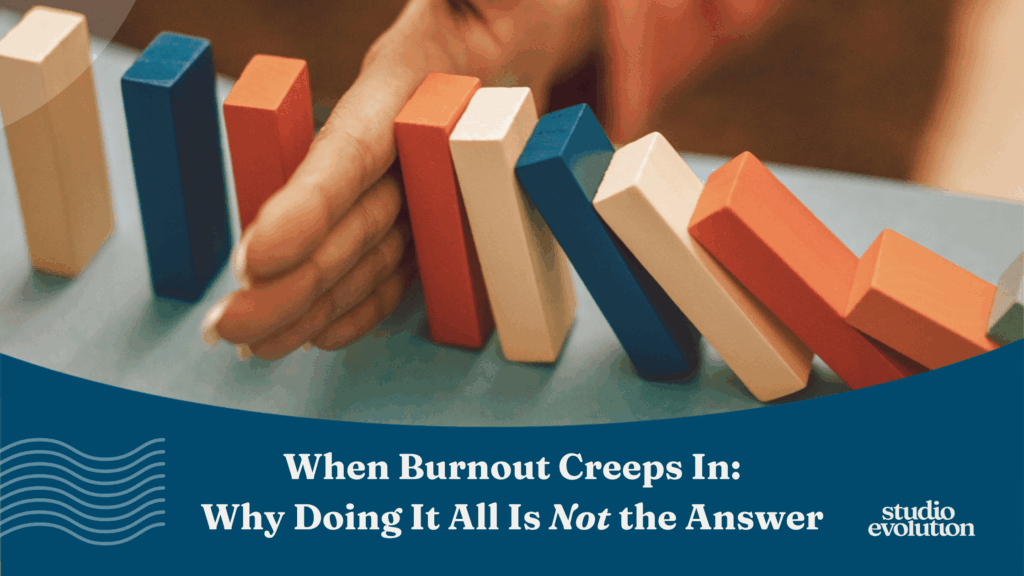Struggling with student drop-off or feeling like families just aren’t sticking around? In this episode of Your Studio Podcast, Chantelle and Michelle reveal how a clear, heart-led onboarding (welcoming) system can increase retention, create stronger connections, and spark organic growth without spending a cent.
If you’re ready to fill your classes and keep students coming back, this episode is the place to start.
While you’re here, you can also grab your FREE Word-of-Mouth Booster Kit: https://studioevolution.com/onboarding.
Please subscribe + review!
Voicemail: https://www.speakpipe.com/LeaveEvolutionAVoicemail
Instagram: @thestudioevolution
YouTube: @thestudioevolution
Facebook: @TheStudioEvolution
Website: studioevolution.com/start
Michelle Hunter (00:35):
Welcome back everybody to the Your Studio Podcast. It is Michelle Hunter and Chantelle Bruinsma here.
Chantelle Bruinsma (00:40):
Hello, lovely ones. How you doing today? How you feeling? How’s your world? What’s going on? We are, what are we doing? Do you just go straight in? Should we just go straight in or are we going to have a segue? Okay, you go one more time. Can I give you a fun fact that Bruinsma
Michelle Hunter (01:07):
Bruinsma
Chantelle Bruinsma (01:07):
What do I say? Bruinsma? Like you’re brewing a beer.
Michelle Hunter (01:12):
Okay. Brewing a beer. I can do that.
Chantelle Bruinsma (01:13):
Bruinsma. I used to say Bruinsma, but I’ve been, it’s Bruinsma
Michelle Hunter (01:19):
And I think that’s why I’ve been saying it.
Chantelle Bruinsma (01:20):
Yeah, Bruinsma. I used to say that. Bruinsma.
Michelle Hunter (01:23):
Hi everybody. Welcome back to the Your Studio Podcast. It is Michelle Hunter here with Chantelle Bruinsma.
(01:36):
Was that right?
Chantelle Bruinsma (01:39):
It’s perfect. It’s just funny how much emphasis we, alright, I’m going to lay it off. Ready? Go. Go. Hello, lovely ones. How are you and Chantelle Bruinsma and I’ve got my bestie, my work wifey, Michelle Hunter. How are you lovely?
Michelle Hunter (01:54):
I’m good. And I’ve been mispronouncing your name for a very long time.
Chantelle Bruinsma (02:01):
I just had a conversation about Bruinsma, Bruinsma and then I believe it is Bruinsma.
Michelle Hunter (02:06):
Bruinsma
Chantelle Bruinsma (02:06):
Bruinsma. Bruinsma. Bruinsma. Bruinsma. But I listen to Trav say it, it’s like Bruinsma. Okay, look, honestly, I’ll take, hey you, so it’s fine. Whatever you want to tell me is fine, but we want to talk about word of mouth today. Word of Mouth. Hands up if it is the largest source of new students in the studio?
Michelle Hunter (02:33):
Tick, tick, tick, tick, tick.
Chantelle Bruinsma (02:34):
Tick, tick, tick, tick, tick, tick, tick. Hands up. If it’s your favorite way to get new students through the door versus complicated marketing strategy.
Michelle Hunter (02:40):
Tick, tick, tick, tick, tick, tick, tick, tick.
Chantelle Bruinsma (02:41):
Right? How many of you have a referral strategy, but maybe it’s not fabulous, it’s like you get a $20 credit or you get some merchandise or something like, yeah, get a bit of coffee, Amazon gift card, bottle of wine, something like that. And you’ve got one, but it’s not necessarily, people aren’t hugely motivated by it, right?
Michelle Hunter (03:05):
Yep.
Chantelle Bruinsma (03:06):
I dunno. How do you feel about that, Michelle? If someone came to you like a business said like, oh, you’ll get $25 if you refer a friend. What’s your relationship with that?
Michelle Hunter (03:16):
It’s got to be worth it. It’s got to be worth my time. We’re busy. It’s not more on the monetary value. It’s probably like if it’s an alignment with my values.
Chantelle Bruinsma (03:28):
Yeah.
Michelle Hunter (03:28):
That makes sense.
Chantelle Bruinsma (03:29):
I’m not going to start calling up my friends to get a $20 Amazon voucher. No, that feels crappy. The only reason I’m going to talk about you is if I am genuinely in love with what you do.
Michelle Hunter (03:39):
That’s right. That’s right.
Chantelle Bruinsma (03:40):
And if I do, I genuinely am someone who is going to tell everyone.
Michelle Hunter (03:44):
Yeah, yeah, exactly.
Chantelle Bruinsma (03:45):
I’m that person. You that person, Michelle?
Michelle Hunter (03:47):
I’m a sneezer. I’m such a sneezer. We’ve talked about that. We’ll just spread it around.
Chantelle Bruinsma (03:52):
Spread the love. Germs everywhere. Germs everywhere.
Michelle Hunter (03:55):
You know what’s fascinating with word of mouth strategy, and I think people really underestimate how powerful it is because we’ve met studios who go, I do know marketing. And it’s like, what? Sorry, you’re at capacity. How is it? You are a hugely successful studio. And that points to that they do this so well.
Chantelle Bruinsma (04:14):
Yeah, and this is strategy. There is a huge strategic underpinning to word of mouth, and it lies in what I think is the most underestimated, the most kind of important little piece of the entire puzzle of the student’s journey. And it’s called Onboarding. How you onboard every new student sets the tone for fricking everything in your business. I’m telling you, Onboarding is the secret to retention. Onboarding is the secret to culture. Onboarding is the secret to ease of kind of systems and less kind, less communication. There’s feedback, less questions. Onboarding is a secret to getting capacity classes and onboarding is a secret therefore to profitability. So in my opinion, it solves every problem in your business, less people reaching out to you, more students through the door, making you more money. Thank you. Yes, please.
Michelle Hunter (05:05):
Do you want to know something funny Chantelle?
Chantelle Bruinsma (05:06):
Tell me something hilarious.
Michelle Hunter (05:08):
When I started working with Studio Evolution many, many years ago, almost 10 years ago, every time my email would go off, my husband would go onboard, onboard, onboard, because we would talk about onboarding so much and he’d never heard that term before.
Chantelle Bruinsma (05:25):
I didn’t know this story. That’s so
Michelle Hunter (05:25):
No. So every time my phone would go, ding here, he get I got to onboard. onboard, onboard because I worked in the communications right in the operations at the time. So it really is so pinnacle.
Chantelle Bruinsma (05:37):
Yeah, we did put a lot of, we put so much resource and care and heart into onboarding of our clients. That’s true. I didn’t know that. That’s funny, Mich. That’s so funny. You can see him say onboard, onboard, onboard. But it’s true because the games are infinite right. And if you are onboarding a new student in your studio, here’s the real win, right? My intention is that every new student that enrols in your studio within eight to 12 weeks, enrols another student on your behalf. I call it Daisy Chain Referral Strategy. So that every student links to another one, links to another one, links to another one. And this is done through a very strategic onboarding strategy. So we’ve got 12 weeks to immerse them in feeling connected, feeling a beautiful sense of belonging, but not only that, to teach them how to talk about your studio, what to say, how to invite someone in. We have got this beautiful chance to really give them permission and the tools to lovingly and very carefully say, Hey, it’s okay for you to bring people and here’s how to do it. But most studios aren’t doing anything like that, right? Anything like it.
Michelle Hunter (06:46):
So it’s not just click this 24 page PDF to know what color leggings to wear to the concert. It’s not just that, oh,
Chantelle Bruinsma (06:52):
Oh my god, it kills me.
Michelle Hunter (06:54):
Cause I’ve got one of them.
Chantelle Bruinsma (06:54):
Kills me, kills me, kills me, kills me. That’s right. Most onboarding for studios is that they send their info pack, their handbook, and it never gets read. And then you get pissed off that you get emails from people that they didn’t read, Page 17, Paragraph 4, Clause 3 of this particular like how to do a makeup class and they didn’t read it. And you get annoyed. And it’s because of course no one’s reading your handbook. No one can process that amount of information. It’s not the way to do it. That’s not onboarding. Okay? There is a whole different approach. Now, there’s four sections to onboarding that I’m passionate about, and the first is this, it’s communication of culture. The first intention with onboarding is to share who you are and what you stand for and what you care about, how we treat each other to really bring your heart.
(07:43):
You are bringing someone into this sacred space that you’re creating, and it’s important from the word go that you really let them know, Hey, this is how we do things here and this is what you can expect and this is what you’re going to receive. And this is what’s important. This is where you share your mission. It’s where you share your values. It’s where you tell stories. We had the most awesome thing happen in a Key Training in Evolution the other day, Michelle, Donna, one of our Evolution members, said that she’d rolled out this kind of our onboarding strategy and she legitimately got a phone call from a new student who hadn’t even come to their first class. This is wild. You’re going to think I’m making this up, but this is legit truth. She hadn’t come to her first class yet. She just received the onboarding emails, getting her ready, and she called to say, these emails are so beautiful. Thank you so much.
Michelle Hunter (08:32):
Yeah, okay. Because it’s not the norm. No, it’s not the norm.
Chantelle Bruinsma (08:37):
It’s not.
Michelle Hunter (08:38):
You are expecting. It should be. It should be right. Because relying on a teacher who is probably so immersed in their class, and then when a new student comes, they’re not focusing on communicating the mission, the values. They might not see the mission and values printed on the wall. They’re rushing to their first class. It has to be communicated in a different way.
Chantelle Bruinsma (08:57):
But how beautiful that people are coming in already feeling the feels.
Michelle Hunter (09:02):
It would change the whole dynamic of the first experience.
Chantelle Bruinsma (09:05):
Yeah, it’s lovely. So we are going to front end all of your communications with more emotion. That’s the first thing. We’re going to get more heart, more communication of why this is important. What you’re going to notice because of this is why things are the way they are, right? The other thing I want to empower you guys to do in this process is what I like to call explicit expectations. This is where in onboarding you have the chance to be really clear. I love the Brené Brown phrase. Clear is kind, unclear is unkind. So be really on the front foot with what you want people to know. I would like a dedicated email in this sequence about makeup classes. Don’t leave it onto Page 17, Paragraph 4, bring the most important things and highlight them so you can let them know. Over the next 12 weeks, I’m going to send you a bunch of emails helping you to feel really confident and comfortable here in the studio so you can understand how things work so that you can have the best experience.
(10:04):
And in that sequence one of the emails, there’s going to be like, well, you’re probably wondering about makeup classes. Here’s how easy and simple it is for families. Here’s what to know, dah, dah, dah, dah. I want you to be explicit. I want you to be more strongly communicative, more open about your payment processes. If your tuition is 21 days in arrears, this is what’s going to happen. I think we kind of pussyfoot around kind of like, I don’t want to come across too strong. I don’t want to bring this to their attention. But if you don’t, then there’s ambiguity and uncertainty and then they have these questions. If you beautifully just bring it to the front and we are going to just tap it a few times, you assume that they’re not reading your handbook. So we’re going to just bring out the important things and maybe do a multiple few taps so they are confident. It’s incredibly important that we are more explicit in your expectations of what they can expect and what you want to expect from your students as well. And that is the secret to healthy relationships. Actually, I think Michelle, that’s what I’ve learned from marriage.
Michelle Hunter (11:05):
Yeah, I was going to say in relationships in general, not just the studio owner and student dynamic.
Chantelle Bruinsma (11:11):
It’s the truth. So communication of culture straight at the bat, bring more heart to the front. Number two is explicit expectations, really being more clear in how what you want ’em to understand. The third bit is the Retention Intention. So as part of onboarding, you want to start paying to the picture of you are not just here for a six week trial, you’re not here for a six week kind of intro pack. You’re not just here for a couple of weeks here. This is where you’re going to go. So in onboarding, we start really priming them for the long haul. We start priming them for all the way that you want them to go through the studio. So after this program, the next program you’re going to step into is this. And hey, you might like to pick up an extra class is a great chance for a bit of an upsell.
(11:54):
My friends, you may be interested in. This is a perfect pair to do with your current class. Start introducing them to the retention flow through your studio so that they can actually start imagining and pitching themselves go through. Ask what you want, right? We’re going to set the tone from the beginning. And the fourth element of really successful onboarding is this referral invitation. So what you might do is you would have an email that beautifully invites your current students to talk about your student. You’re going to put that kind of languaging in. So you might say, you are one of our dream students. We are so loving watching you flourish every week and our teachers giving great feedback on how you’re progressing. We also know that you may have people in your life who might also like to come to the studio, maybe a neighbor or a colleague or a relative, and you say, if you are wanting to share about the studio, you might like to use words about, talk about the community.
(12:51):
That’s really important. You might like to talk about the level of connection that you feel. You also might like to notice how to share about how personally connected you are with the teacher. You choose the words that you think both most represent what you care about. You bring that in. And then in the email you’re saying, if they’d like to come in, here’s the next step for you. You can send them to this page or you could do it like that. I wouldn’t even personally have a referral kind of process. Just thank people genuinely afterwards is just surprise them with, delight them with after they’ve done it, teach ’em how to do it and then wow, acknowledge it on the back end. I don’t think you need to lead with incentives. I personally don’t think it’s hugely effective. Respond with gratitude. Much better way to do it. Yeah,.
Michelle Hunter (13:40):
And could you be a bit strategic when you send that email, if we’re not going to lead with an incentive, could it be like for instance, you know that in their first six weeks they get a connection point with the teacher or something like that? Could you be a bit more strategic with when you send that email?
Chantelle Bruinsma (13:54):
Well, let’s think about for you guys. So when is it that you notice that your students get that sparkly eyed moment that they’re in? They are kind of connected there. It might be for you, it might be four weeks, it might be after about six weeks. They really, they’ve softened, they’ve settled, they feel like they really belong here. How many weeks does it take for you to really notice it? That is the time we’re going to send that email when they’re most feeling it. You don’t want to send it too long after that point because you’ve kind of lost the sparkle in there, right? You want to catch them right when it’s on the tip of their tongue. This is such an important piece of the puzzle, right, Michelle? You get onboarding, right? You get more clarity happening with all your students. You’ve got more alignment with the whole intention of the studio.
(14:37):
You’ve got more retention positioning happening. You’ve also got more gentle but consistent invitations for people to share and talk about you. And there’s a bunch of different other ways to do it. But mainly by developing this automated email sequence that really is holistically guiding people onwards. It just makes your life such a joy. And I’ve actually recorded a training where you can learn more about these elements and I’ve written the first three emails for you that you can tweak and make your own and start sending out to all of your new students for onboarding because this is important. This stuff matters. And if you get this in your business, I’m excited to see what happens. So if you would like to jump on in, you can access this resource straight away, watch the video and access the document, start kind of tweaking it. Super easy to go. All you have to do is go to studioevolution.com/onboarding. Again, this is so valuable for you to get this sorted out in your business. We have seen studios transform in their results simply by upgrading their onboarding. Because when you start working with a company that cares about onboarding, it’s like you just feel, oh my gosh, so calm. And then it’s easy to bring more people into the mix. It feels good, right, Michelle?
Michelle Hunter (15:52):
It feels good. And bottom line, it’s more profitable as well because your retention’s better. And two, you’re not spending so much money on marketing or paid data strategy because word of mouth is the cheapest way to grow your studio.
Chantelle Bruinsma (16:05):
For sure. And I actually remember it is one of your superpowers, Michelle. I remember one of our team members, Kelly saying to me that even from our team onboarding, that’s a whole nother conversation, but she was saying that your onboarding, she’d never experienced anything like it in her entire career. It’s the truth.
(16:22):
You’re very good at it.
Michelle Hunter (16:24):
You’re too kind. I’m not, it’s facts, but it’s so true. You have a very small window to make an impression. And it’s not just retention of students, it can be retention of team, teachers. It’s really, really pinnacle of getting the tone straight off the bat and clearly communicating your expectations.
Chantelle Bruinsma (16:42):
Yeah, and you do that, right? People want to stay with you. Share your heart from the beginning and watch them stick and watch them share. Well go on over to studioevolution.com/onboarding. Jump on in and start tweaking those emails. I’m excited to see you get this up and rolling in your business beautiful ones.
Michelle Hunter (17:01):
Thanks friends. We’ll see you soon.
Chantelle Bruinsma (17:03):
Bye
Michelle Hunter (17:03):
Bye.
